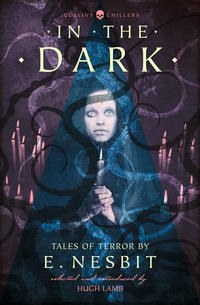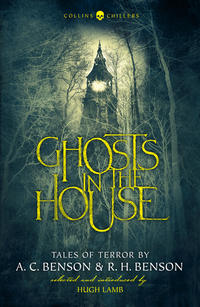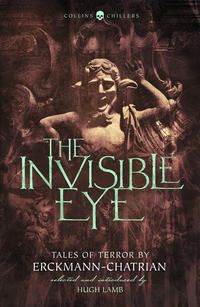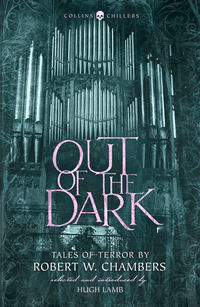
Полная версия
Out of the Dark: Tales of Terror by Robert W. Chambers

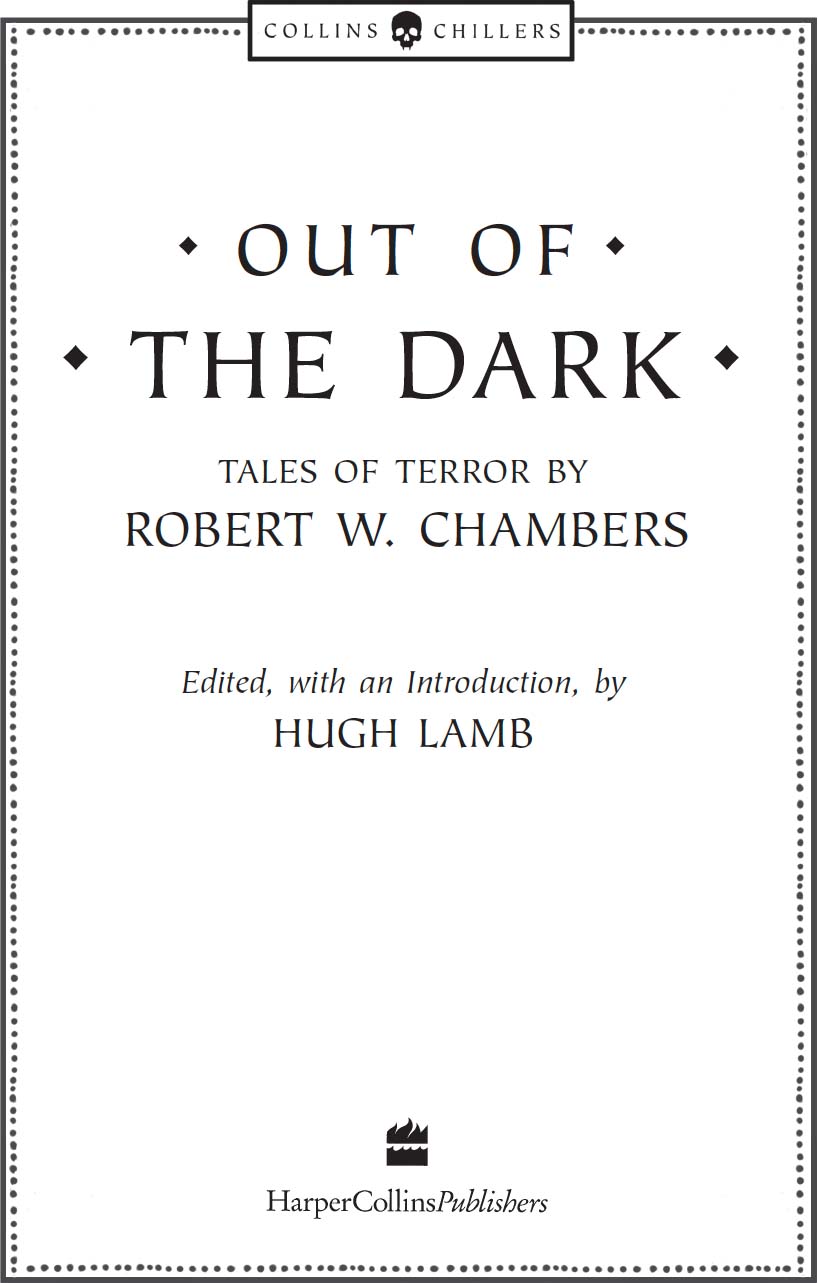
Copyright
HarperCollinsPublishers
1 London Bridge Street
London SE1 9GF
www.harpercollins.co.uk
Collins Chillers edition published 2018
First published in Canada in two volumes by Ash-Tree Press 1998, 1999
Selection, introduction and notes © Hugh Lamb 2018
Cover design by Mike Topping © HarperCollinsPublishers Ltd 2018
Cover photographs © Shutterstock.com
A catalogue copy of this book is available from the British Library.
This novel is entirely a work of fiction. The names, characters and incidents portrayed in it are the work of the author’s imagination. Any resemblance to actual persons, living or dead, events or localities is entirely coincidental.
All rights reserved under International and Pan-American Copyright Conventions. By payment of the required fees, you have been granted the non-exclusive, non-transferable right to access and read the text of this e-book on screen. No part of this text may be reproduced, transmitted, down-loaded, decompiled, reverse engineered, or stored in or introduced into any information storage and retrieval system, in any form or by any means, whether electronic or mechanical, now known or hereinafter invented, without the express written permission of HarperCollins.
Source ISBN: 9780008265366
Ebook Edition © October 2018 ISBN: 9780008265373
Version: 2018-09-04
Dedication
This collection of stories by a New York author is dedicated, with great affection, to another writer from that city – my daughter-in-law, Margaret Reyes Dempsey.
Contents
Cover
Title Page
Copyright
Dedication
Preface
PART ONE: ORIGINS – 1895–1899
Introduction
The Yellow Sign
A Pleasant Evening
Passeur
In the Court of the Dragon
The Maker of Moons
The Mask
The Demoiselle d’Ys
The Key to Grief
The Messenger
PART TWO: DIVERSIONS – 1900–1938
Introduction
Out of the Depths
Un Peu d’Amour
Grey Magic
Samaris
In Search of the Great Auk
The Death of Yarghouz Khan
The Sign of Venus
The Third Eye
The Seal of Solomon
The Bridal Pair
In Search of the Mammoth
Death Trail
The Case of Mr Helmer
Bibliography
Acknowledgements
Also in this series
About the Publisher
PREFACE
Robert William Chambers, in his day one of America’s most popular authors, was born in New York, 26 May 1865, the son of New York lawyer William P. Chambers. The family were of Scottish descent. He had an early interest in art, studying at the Art Students League in New York, and in 1886 he went to Paris where he studied at the Academie Julien for seven years. He was accompanied by Charles Dana Gibson, destined to become one of America’s most celebrated portrait painters, who also illustrated some of Chambers’s books in later life.
When Chambers and Gibson returned to America in 1893, it was Gibson who got the lucky break into an art career. Chambers turned to writing instead. His first book, In the Quarter (1894), was based on his experiences in France. It sold fairly well, enough to encourage him to try his hand at a second book based on his French sojourn. The King in Yellow (1895) turned out to be an instant success and set Chambers on a writing career that lasted forty years. It was also one of the most successful books of the macabre, a genre to which Chambers would return only occasionally during his life.
Out of the Dark contains the best of Chambers’s work in this field, taken from books as far apart in publication as 1895 and 1920. By the time of his death on 16 December 1933, Robert W. Chambers had produced nearly 100 books (88 are listed in the British Library Catalogue in Britain alone). Sadly, only a very few dealt with the macabre.
INTRODUCTION
The tradition of the American in Paris – the expatriate enjoying himself in one of Europe’s most appealing cities – goes back way beyond such luminaries as Henry Miller or Ernest Hemingway. So many Americans got to know the place as a result of the First World War that it was quite forgotten that others had been there before, under less trying circumstances.
When Robert Chambers and Charles Dana Gibson went there to study art in 1886, we must hope they had as good a time as Miller (while perhaps not so athletic). They stayed there for seven years, after all. What did come out of it was a book of tales of terror seldom surpassed in the genre, yet in its own way a very unsatisfying work, making the reader wish for more. Which statement just about sums up the writing career of Robert W. Chambers, as far as enthusiasts in this genre are concerned.
Chambers, despite displaying an early, unique talent for tales of terror, returned to them very seldom in later life. He was an astute writer, who knew what sold well, and produced the goods accordingly. Spy novels, adventure stories, society dramas, social comedies – if that’s what the public wanted, then Chambers was happy to oblige.
He was one of the authors featured in ‘How I “Broke into Print”’, an article in the Strand Magazine’s November 1915 edition, and had this to say on his first major success:
My most important ‘break into print’ was with a collection of short stories of a weird and uncanny character, entitled The King in Yellow, which the public seemed to like. So flatteringly was it received, indeed, that it decided me to devote all my time to fiction, and so I have been writing ever since. I cannot say which of my books I prefer, because just as soon as I have finished a story I dislike it. I am continually trying to do something better, so that I presume my ‘best’ book will never be written.
The King in Yellow (1895) is at the same time one of the most enjoyable yet one of the most irritating books in the fantasy catalogue. At its best – as in ‘The Yellow Sign’ – it is genuinely scary, with original ideas seldom equalled. At its worst – as in ‘The Prophets’ Paradise’ (not included here: think yourselves lucky) it is obscure, pompous, and overwritten.
The title refers to a play, rumoured to be so evil that it shatters lives and lays waste souls. We never get to see much of it; in fact, this much-vaunted evil work doesn’t even appear in some of the stories. Where it does, as in ‘The Yellow Sign’ or ‘The Mask’, it adds untold atmosphere. Where it doesn’t, as in ‘The Street of the First Shell’ (again not included), then the book is a distinct let-down. At times, it is hard to see what Chambers is intending with this erratic book. While it is an indispensable part of any self-respecting horror reader’s library, I have to say that it does not live up to its reputation.
And yet, as strange as anything (and at a time when M.R. James was just starting his ghost story career), there comes a line in ‘In the Court of the Dragon’ which could not be more Jamesian:
… I wondered idly … whether something not usually supposed to be at home in a Christian church, might have entered undetected, and taken possession of the west gallery.
‘The Yellow Sign’ is by far and away the most reprinted story from The King in Yellow, and earned the praise of H.P. Lovecraft, among others. It very quickly conjures up an atmosphere of death and decay (count the words in this vein that appear in just the first few paragraphs) and, in the form of the church watchman, one of the genre’s most disturbing figures.
‘In the Court of the Dragon’ and ‘The Demoiselle D’Ys’ are lesser items, though ‘In the Court of the Dragon’ has its own scary church figure. ‘The Mask’ limply trails its fingers in the waters of science fiction, like so many tales from the 1890s. (An odd fact: Chambers mentions Gounod’s ‘Sanctus’ in ‘The Mask’, as a symbol of purity; Werner Herzog used the music over the closing credits of his film Nosferatu in 1979, a most un-pure film.)
While Chambers borrowed various things from Ambrose Bierce to embellish The King in Yellow, like the names Carcosa and Hastur, he has inspired precious few imitators himself. There may be one: Sidney Levett-Yeats, the British writer, introduces a book written by the devil (in his story ‘The Devil’s Manuscript’ (1899)) which ruins lives when read. It is titled The Yellow Dragon.
As The King in Yellow proved to be a winner, Chambers turned to writing full-time, while still keeping up his artistic habits (though, oddly, he never seems to have illustrated any of his own books, Charles Dana Gibson certainly illustrated some for him). He supplied illustrations for magazines such as Life, Truth, and Vogue, and was photographed for The King in Yellow, palette in hand.
He married Elsa Vaughn Moller in 1898, and they spent their married life at Broadalbin, an 800 acre estate in the Sacandaga Valley, northern New York State. Broadalbin had been in the Chambers family since his grandfather William Chambers first settled there in the mid-1800s. This beautiful country estate in the Adirondacks included a game preserve (where it seems Chambers never shot) and a fishing lake.
Broadalbin House was remodelled by Chambers’s architect brother, William Boughton Chambers, and was crammed with the family’s and Chambers’s collection of books, paintings, and Oriental objets d’art. His collection of butterflies was said to be one of the most complete in America.
Chambers spent most of the year at Broadalbin, travelling into New York to work in an office which he kept secret from his family (so much so that they had trouble finding it when he died). His chauffeur would drop him off and pick him up again at a spot some distance from the office.
Chambers lavished much care and affection on Broadalbin, planting thousands of trees on the estate. When he died, he was buried under one of the oaks.
Not all his time at Broadalbin was contented. He saw 200 acres of the estate vanish under the waters of the Sacandaga Reservoir which now covers much of the valley. He would have been even more desolate at the fate of his carefully planted trees (see Part Two).
Though part of the house at Broadalbin was demolished, the building still stands, now owned by the Catholic Church. It was abandoned (literally overnight, on the death of Chambers’s widow in 1938) for some years, and was vandalised terribly. It is reported that Chambers’s papers were used by intruders and squatters to light fires.
Chambers loved the outdoor life: it shows up in his writing time and again, where his descriptions of nature, scenery and forests are superbly evocative. A keen hunter, shooter and fisher, his characters are so often engaged in these pursuits as to suggest Chambers himself at play. He could apparently call most kinds of birds and was well versed in Indian languages (see ‘The Key to Grief’).
He must have been the most fortunate of authors: successful, rich and surrounded by the life he loved and wrote about. It is easy to see why he was reported to be so popular with his estate workers and neighbours in this period of his life.
To follow up the success of The King in Yellow, Chambers published another book of short stories in 1896, The Maker of Moons.
The title story, included here, is in many ways a practice run at his 1920 novel The Slayer of Souls. As in that book, we have ample helpings of the American secret service (fine men all), Oriental magic, and strange goings-on in the forest. It also shows how Chambers would finally drift away from the fantasy genre, into the world of espionage and adventure. ‘The Maker of Moons’ is nonetheless a superb fantasy, quite unlike anything else around at the time, and holds up well, even now.
From the same book comes ‘A Pleasant Evening’, another indication of the way Chambers would develop. Here, in a fairly traditional theme, he shows the skill that would lead to The Tree of Heaven (in Part Two) – the writing of neat and well crafted supernatural tales, not necessarily meant to frighten.
The next year, Chambers published The Mystery of Choice, a fine set of stories which was a series of vaguely connected tales, set mainly in France, but this time not in Paris. By far and away the most powerful of them was ‘The Messenger’.
This is a long, sometimes rambling story that nevertheless guides the reader along to a most eerie conclusion. The setting – coastal Brittany – has seldom been used to such effect, and the historical tale behind the story’s events has a grotesque ring of truth. This is one of Chambers’s best stories, and its use of the traditional masked figure has never been bettered.
‘Passeur’ from the same book, is a much shorter, traditional ghost story, easily guessed by anyone familiar with the genre. But Chambers is too good to give it all away completely; relish the scenery he depicts in the closing paragraphs.
Sticking out like a sore thumb from the rest of the stories in the book, ‘The Key to Grief’ is set far away from France. Chambers might have borrowed the odd name or two from Bierce for The King in Yellow; here he all but ransacked Bierce’s living-room. This is a shameless reworking of Bierce’s ‘An Occurrence at Owl Creek Bridge’, which still has its own sense of the unknown, and is included here by virtue of its unusual location.
The Mystery of Choice contained a lot of what was to become the cardinal vice of Chambers’s writing as time went by: an awful tendency to be rather soppy, especially in his romantic scenes. This style probably didn’t read too well in the 1890s; nowadays it just grates alarmingly.
After 1900 Chambers moved steadily away from his roots in the fantasy genre, but still – though not often enough – popping back from time to time, as will be seen in Part Two.
Hugh Lamb
Sutton, Surrey
January 2018
THE YELLOW SIGN
‘Let the red dawn surmise
What we shall do,
When this blue starlight dies
And all is through.’
I
There are so many things which are impossible to explain! Why should certain chords in music make me think of the brown and golden tints of autumn foliage? Why should the Mass of Sainte Cécile send my thoughts wandering among caverns whose walls blaze with ragged masses of virgin silver? What was it in the roar and turmoil of Broadway at six o’clock that flashed before my eyes the picture of a still Breton forest where sunlight filtered through spring foliage and Sylvia bent, half curiously, half tenderly, over a small green lizard, murmuring: ‘To think that this also is a little ward of God’?
When I first saw the watchman his back was toward me. I looked at him indifferently until he went into the church. I paid no more attention to him than I had to any other man who lounged through Washington Square that morning, and when I shut my window and turned back into my studio I had forgotten him. Late in the afternoon, the day being warm, I raised the window again and leaned out to get a sniff of air. A man was standing in the courtyard of the church, and I noticed him again with as little interest as I had that morning. I looked across the square to where the fountain was playing and then, with my mind filled with vague impressions of trees, asphalt drives, and the moving groups of nursemaids and holiday-makers, I started to walk back to my easel. As I turned, my listless glance included the man below in the churchyard. His face was toward me now, and with a perfectly involuntary movement I bent to see it. At the same moment he raised his head and looked at me. Instantly I thought of a coffin-worm. Whatever it was about the man that repelled me I did not know, but the impression of a plump white grave-worm was so intense and nauseating that I must have shown it in my expression, for he turned his puffy face away with a movement which made me think of a disturbed grub in a chestnut.
I went back to my easel and motioned the model to resume her pose. After working awhile I was satisfied that I was spoiling what I had done as rapidly as possible, and I took up a palette knife and scraped the color out again. The flesh tones were sallow and unhealthy, and I did not understand how I could have painted such sickly color into a study which before that had glowed with healthy tones.
I looked at Tessie. She had not changed, and the clear flush of health dyed her neck and cheeks as I frowned.
‘Is it something I’ve done?’ she said.
‘No – I’ve made a mess of this arm, and for the life of me I can’t see how I came to paint such mud as that into the canvas,’ I replied.
‘Don’t I pose well?’ she insisted.
‘Of course, perfectly.’
‘Then it’s not my fault?’
‘No, it’s my own.’
‘I’m very sorry,’ she said.
I told her she could rest while I applied rag and turpentine to the plague spot on my canvas, and she went off to smoke a cigarette and look over the illustrations in the Courier Français.
I did not know whether it was something in the turpentine or a defect in the canvas, but the more I scrubbed the more that gangrene seemed to spread. I worked like a beaver to get it out, and yet the disease appeared to creep from limb to limb of the study before me. Alarmed I strove to arrest it, but now the color on the breast changed and the whole figure seemed to absorb the infection as a sponge soaks up water. Vigorously I plied palette knife, turpentine, and scraper, thinking all the time what a séance I should hold with Duval who had sold me the canvas; but soon I noticed that it was not the canvas which was defective nor yet the colors of Edward. ‘It must be the turpentine,’ I thought angrily, ‘or else my eyes have become so blurred and confused by the afternoon light that I can’t see straight.’ I called Tessie, the model. She came and leaned over my chair blowing rings of smoke into the air.
‘What have you been doing to it?’ she exclaimed.
‘Nothing,’ I growled, ‘it must be this turpentine!’
‘What a horrible color it is now,’ she continued. ‘Do you think my flesh resembles green cheese?’
‘No, I don’t,’ I said angrily, ‘did you ever know me to paint like that before?’
‘No, indeed!’
‘Well, then!’
‘It must be the turpentine, or something,’ she admitted.
She slipped on a Japanese robe and walked to the window. I scraped and rubbed until I was tired and finally picked up my brushes and hurled them through the canvas with a forcible expression, the tone alone of which reached Tessie’s ears.
Nevertheless she promptly began: ‘That’s it! Swear and act silly and ruin your brushes! You have been three weeks on that study, and now look! What’s the good of ripping the canvas? What creatures artists are!’
I felt about as much ashamed as I usually did after such an outbreak, and I turned the ruined canvas to the wall. Tessie helped me clean my brushes, and then danced away to dress. From the screen she regaled me with bits of advice concerning whole or partial loss of temper, until, thinking, perhaps, I had been tormented sufficiently, she came out to implore me to button her waist where she could not reach it on the shoulder.
‘Everything went wrong from the time you came back from the window and talked about that horrid-looking man you saw in the churchyard,’ she announced.
‘Yes, he probably bewitched the picture,’ I said yawning. I looked at my watch.
‘It’s after six, I know,’ said Tessie, adjusting her hat before the mirror.
‘Yes,’ I replied, ‘I didn’t mean to keep you so long.’ I leaned out of the window but recoiled with disgust, for the young man with the pasty face stood below in the churchyard. Tessie saw my gesture of disapproval and leaned from the window.
‘Is that the man you don’t like?’ she whispered.
I nodded.
‘I can’t see his face, but he does look fat and soft. Someway or other,’ she continued, turning to look at me, ‘he reminds me of a dream – an awful dream I once had. Or,’ she mused, looking down at her shapely shoes, ‘was it a dream after all?’
‘How should I know?’ I smiled.
Tessie smiled in reply.
‘You were in it,’ she said, ‘so perhaps you might know something about it.’
‘Tessie! Tessie!’ I protested, ‘don’t you dare flatter by saying that you dream about me!’
‘But I did,’ she insisted. ‘Shall I tell you about it?’
‘Go ahead,’ I replied, lighting a cigarette.
Tessie leaned back on the open window-sill and began very seriously.
‘One night last winter I was lying in bed thinking about nothing at all in particular. I had been posing for you and I was tired out, yet it seemed impossible for me to sleep. I heard the bells in the city ring, ten, eleven, and midnight. I must have fallen asleep about midnight because I don’t remember hearing the bells after that. It seemed to me that I had scarcely closed my eyes when I dreamed that something impelled me to go to the window. I rose, and raising the sash leaned out. Twenty-fifth Street was deserted as far as I could see. I began to be afraid; everything outside seemed so – so black and uncomfortable. Then the sound of wheels in the distance came to my ears, and it seemed to me as though that was what I must wait for. Very slowly the wheels approached, and, finally, I could make out a vehicle moving along the street. It came nearer and nearer, and when it passed beneath my window I saw it was a hearse. Then, as I trembled with fear, the driver turned and looked straight at me. When I awoke I was standing by the open window shivering with cold, but the black-plumed hearse and the driver were gone. I dreamed this dream again in March last, and again awoke beside the open window. Last night the dream came again. You remember how it was raining; when I awoke, standing at the open window, my night-dress was soaked.’
‘But where did I come into the dream?’ I asked.
‘You – you were in the coffin; but you were not dead.’
‘In the coffin?’
‘Yes.’
‘How did you know? Could you see me?’
‘No; I only knew you were there.’
‘Had you been eating Welsh rarebits, or lobster salad?’ I began laughing, but the girl interrupted me with a frightened cry.
‘Hello! What’s up?’ I said, as she shrank into the embrasure by the window.
‘The – the man below in the churchyard; he drove the hearse.’
‘Nonsense,’ I said, but Tessie’s eyes were wide with terror. I went to the window and looked out. The man was gone. ‘Come, Tessie,’ I urged, ‘don’t be foolish. You have posed too long; you are nervous.’
‘Do you think I could forget that face?’ she murmured. ‘Three times I saw the hearse pass below my window, and every time the driver turned and looked up at me. Oh, his face was so white and – and soft! It looked dead – it looked as if it had been dead a long time.’


